Pablo Alvarez
Posts by Pablo Alvarez
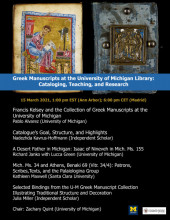
We are very pleased to invite you all to the fourth session of the Virtual Encounters on Book History, a series organized by Pablo Alvarez (University of Michigan) and Benito Rial Costas (Universidad Complutense de Madrid). Our fourth webinar is a celebration of two landmark publications based on the extensive collection of Greek manuscripts at the University of Michigan Library: Nadezhda Kavrus-Hoffmann, Catalogue of Greek Manuscripts at the University of Michigan in Ann Arbor. Vol. 1. Ann Arbor, MI: University of Michigan Press, 2021; and Julia Miller, Tradition and Individuality: Bindings from the University of Michigan Greek Manuscript Collection. Ann Arbor, MI: The Legacy Press, 2021. Our speakers will focus on various aspects of this important collection of manuscripts, presenting case studies that illustrate their historical, textual, and artistic relevance.
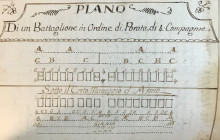
On behalf of the University of Michigan Library, we would like to express our gratitude to Samuel L. Chappell (B.S. 1969) and Roberta J. Chappell (B.S. 1967) for their generous gift that allowed us to acquire a manuscript and an early printed book for our military history collection. Since their graduation from the U-M, Sam and Bobbie have kept in touch with the Library in various ways, including generous donations to advance our academic mission.
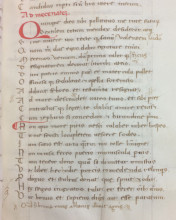
We are very pleased to invite you all to the third session of a series of virtual encounters on various aspects of book history. On this occasion,
our webinar is devoted to textual editing and criticism. Our speakers will discuss innovative approaches to digital technology and scholarship in the edition of literary texts, ranging from Chaucer to James Joyce.
our webinar is devoted to textual editing and criticism. Our speakers will discuss innovative approaches to digital technology and scholarship in the edition of literary texts, ranging from Chaucer to James Joyce.
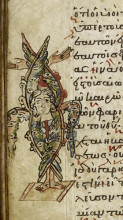
I am very excited to announce the publication of the first volume of a two-volume catalog describing the extensive collection of Greek manuscripts at the University of Michigan Library. Authored by Dr. Nadezhda Kavrus-Hoffmann, this fully illustrated catalog describes the largest collection of Greek manuscripts in America, which consists of 110 codices (bound manuscripts) and fragments ranging from the fourth to the nineteenth century.
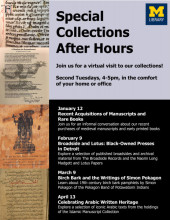
We are very excited to re-launch online our open houses in the Special Collections Research Center! As part of the After Hours series, we have arranged an extraordinary line-up of events for the Winter Semester. Before the pandemic, on the second Tuesday of each month during the academic year, we organized physical displays of themed selections from our collections. Now we are committed to continue this tradition of open houses in the virtual world. All are welcome to join us from the comfort of your home or office to chat with a curator and learn about our collections.

We are pleased to announce the launching of a new online exhibit: "Sacred Hands." This virtual display highlights an extraordinary selection of manuscripts containing the sacred texts of the three Abrahamic religions: Judaism, Christianity, and Islam. It includes manuscripts that are highly treasured for their textual and artistic value, such as a tenth-century Torah, the earliest known papyrus of St. Paul's Epistles, early illuminated Byzantine manuscripts of the Four Gospels, and a wide selection of manuscripts containing the Qur'an.
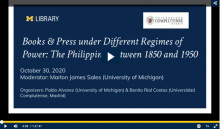
We are very pleased to announce that the video of the Webinar on book history in the Philippines (1850-1950) that we hosted last October is now widely available.
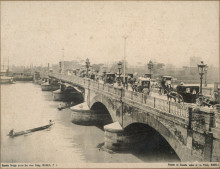
We are very pleased to invite you all to the second session of a series of virtual encounters on various aspects of book history. On this occasion, our online meeting is devoted to several issues regarding book production, the press, and readership in the Philippines under different administrations between 1850 and 1950.

We are very pleased to announce that the video of the Bookbinding webinar that took place on July 6 is now available. It was the first session of a series of virtual encounters on book history organized by the University of Michigan Library and Universidad Complutense de Madrid.
![Detail from copperplate describing the bookbinding workshop, from Encyclopédie, ou Dictionnaire raisonné des sciences, des arts et des métiers, par une société de gens de lettres. 17 vols. 11 vols of plates. (Paris: Briasson [etc.] Genève, C. J. Panckoucke, G. Cramer et S. de Tournes, 1762-1776)](/sites/default/files/styles/medium/public/plate_25_21_1.jpg?itok=ZBt0QAwg)
We are very pleased to invite you all to the first session of a series of virtual encounters on various aspects of book history. Our first online meeting is devoted to bookbinding and is scheduled for July 6, 11:00 am (EDT). This session, and the series, are organized by Pablo Alvarez (UM) and Benito Rial Costas (UCM), and will be hosted by the University of Michigan Library and the Facultad de Ciencias de la Documentación of the Universidad Complutense de Madrid on Zoom. The session is free of charge and open to all, but registration is required.